Related Research Articles
In North America, a sideshow is an extra, secondary production associated with a circus, carnival, fair, or other such attraction.

Phineas Taylor Barnum was an American showman, businessman and politician remembered for promoting celebrated hoaxes and founding the Barnum & Bailey Circus with James Anthony Bailey.

William Henry Johnson, known as Zip the Pinhead, was an American freak show performer known for his tapered head.

The Cardiff Giant was one of the most famous archaeological hoaxes in American history. It was a 10-foot-tall (3.0 m), roughly 3,000 pound purported "petrified man", uncovered on October 16 1869 by workers digging a well behind the barn of William C. "Stub" Newell, in Cardiff, New York. He covered the giant with a tent and it soon became an attraction site. Both it and an unauthorized copy made by P. T. Barnum are still being displayed. P.T. Barnum's is on display at Marvin's Marvelous Mechanical Museum in Farmington Hills, Michigan.
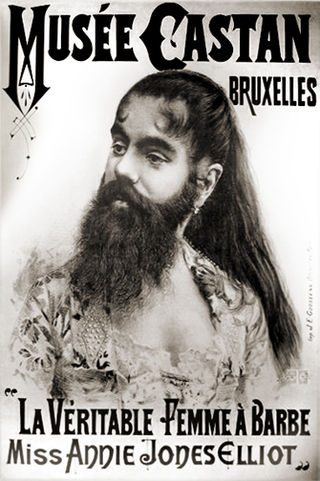
Annie Jones Elliot was an American bearded woman, born in Virginia. She toured with showman P. T. Barnum as a circus attraction. Whether the cause of her condition was hirsutism or an unrelated genetic condition that affects children of both sexes and continues into adult years is unknown. Many photographers, including Mathew Brady, took her portraits during her lifetime, which were widely distributed. As an adult, Jones became the country's top "bearded lady" and acted as a spokesperson for Barnum's "Freaks", a word she tried to abolish from the business. Jones married Richard Elliot in 1881, but divorced him in 1895 for her childhood sweetheart William Donovan, who died, leaving Jones a widow. In 1902, Jones died in Brooklyn of tuberculosis.
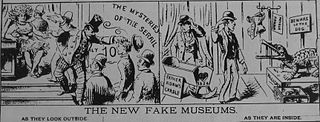
Dime museums were institutions that were popular at the end of the 19th century in the United States. Designed as centers for entertainment and moral education for the working class (lowbrow), the museums were distinctly different from upper middle class cultural events (highbrow). In urban centers like New York City, where many immigrants settled, dime museums were popular and cheap entertainment. The social trend reached its peak during the Progressive Era. Although lowbrow entertainment, they were the starting places for the careers of many notable vaudeville-era entertainers, including Harry Houdini, Lew Fields, Joe Weber, and Maggie Cline.

The Pride of Baltimore was a reproduction of a typical early 19th-century "Baltimore clipper" topsail schooner, commissioned to represent Baltimore, Maryland. This was a style of vessel made famous by its success as a privateer commerce raider, a small warship in the War of 1812 (1812–1815) against British merchant shipping and the world-wide British Royal Navy. After the end of the war, Baltimore Clippers did not have sufficient cargo capacity for normal merchant trade, so some were used in the illegal opium trade into China and vessels of the same type were used in the transatlantic slave trade from Africa.
Pickled punks is the carny term for human babies preserved in jars of preservative such as formaldehyde, which are used as sideshow attractions. Most pickled punks display some sort of anatomical abnormality, such as conjoined twins or polycephaly; however, the deformities present are as varied as the nature of human afflictions. Fake pickled punks, made from rubber or wax, are known as "bouncers" for their tendency to bounce when dropped on the floor.
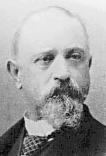
William Cameron Coup was a Wisconsin businessman who partnered with P. T. Barnum and Dan Castello in 1870 to form the "P. T. Barnum's Museum, Menagerie and Circus". Previously Barnum had a museum at a fixed location in New York City and the traveling circus allowed him to bring his curiosities to more paying customers. Coup's innovations were the circus train to transport the materials from town to town. He also came up with the concept of adding a second ring in 1872 and a third ring to the circus in 1881 to allow more people to view the events.

A traveling carnival, usually simply called a carnival, travelling funfair or travelling show, is an amusement show that may be made up of amusement rides, food vendors, merchandise vendors, games of chance and skill, thrill acts, and animal acts. A traveling carnival is not set up at a permanent location, like an amusement park or funfair, but is moved from place to place. Its roots are similar to the 19th century circus with both being fitted-up in open fields near or in town and moving to a new location after a period of time. In fact, many carnivals have circuses while others have a clown aesthetic in their decor. Unlike traditional carnival celebrations, the North American traveling carnival is not tied to a religious observance.
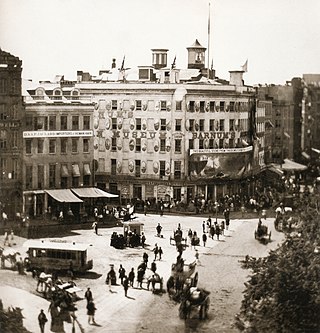
Barnum's American Museum was located at the corner of Broadway, Park Row, and Ann Street in what is now the Financial District of Manhattan, New York City, from 1841 to 1865. The museum was owned by famous showman P. T. Barnum, who purchased Scudder's American Museum in 1841. The museum offered both strange and educational attractions and performances. Some were extremely reputable and historically or scientifically valuable, while others were less so.
William Street Hutchings, also known as Professor Hutchings and the Lightning Calculator, was a 19th-century math prodigy and mental calculator who P. T. Barnum first billed as the "Boy Lightning Calculator". He later worked as a sideshow barker and wrote a book called The Lightning Calculator.

A freak show is an exhibition of biological rarities, referred to in popular culture as "freaks of nature". Typical features would be physically unusual humans, such as those uncommonly large or small, those with intersex variations, those with extraordinary diseases and conditions, and others with performances expected to be shocking to viewers. Heavily tattooed or pierced people have sometimes been seen in freak shows, as have attention-getting physical performers such as fire-eating and sword-swallowing acts.

James Taylor is an American writer and publisher. He co-founded Dolphin-Moon Press in 1973, one of Baltimore's oldest small press publishing houses.

Charles Eisenmann was a famous New York photographer during the late 1880s who worked in the Bowery district.

Jones' Fantastic Museum was a family-oriented museum filled with a unique collection of weird and amazing inventions, strange sideshow attractions, old-time dime museum machines and antique exhibits, originally located in Snohomish County, and later in Seattle, Washington, United States, from 1963 to 1980. It was created by avid collector Walt a.k.a. Doc Jones.
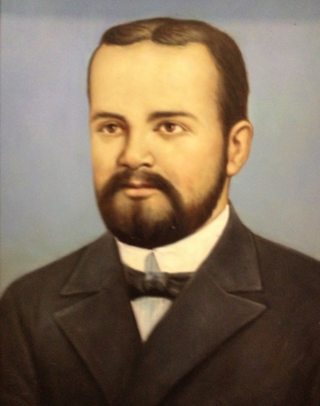
Arthur Taylor Prescott Sr. was a political scientist and educator who was the founding president of Louisiana Tech University in Ruston, Louisiana. Most of his educational administrative career, however, was spent at his alma mater, Louisiana State University in Baton Rouge.

Scudder's American Museum was a museum located in New York City from 1810 to 1841, when it was purchased by P.T. Barnum and transformed into the very successful Barnum's American Museum.

Máximo and Bartola were the stage names of two Salvadoran siblings both with microcephaly and cognitive developmental disability who were exhibited in human zoos in the 19th century. Originally from near Usulután, El Salvador, the siblings were given by their mother to a merchant who promised he would take them to Grenada to be educated and exhibited. They then went through several guardians afterwards. They were eventually billed as "Aztec Children" and an elaborate story was constructed of how they were found in the temple of a lost Mesoamerican city by the name of Iximaya. They toured the U.S. and Europe, appearing before various regents and dignitaries.
Arthur "Artie" Atherton was an American entertainer, showman and circus sideshow performer during the early 20th century, who was billed as "the living human skeleton" or "skeleton dude".
References
- ↑ "Drama of a ball of string - Baltimore Sun". Articles.baltimoresun.com. 2000-02-17. Retrieved 2014-05-25.
- ↑ "Dime Museum Rises from Grave". Roadsideamerica.com. 2010-07-22. Retrieved 2014-05-26.
- ↑ "Baton Rouge, Louisiana". Ourbigtrip.us. 2011-01-26. Retrieved 2014-05-26.
- ↑ "An opening of oddities: Pexcho's American Dime Museum to bring in sideshow acts for first day". www.augustachronicle.com. Archived from the original on 2019-08-04.